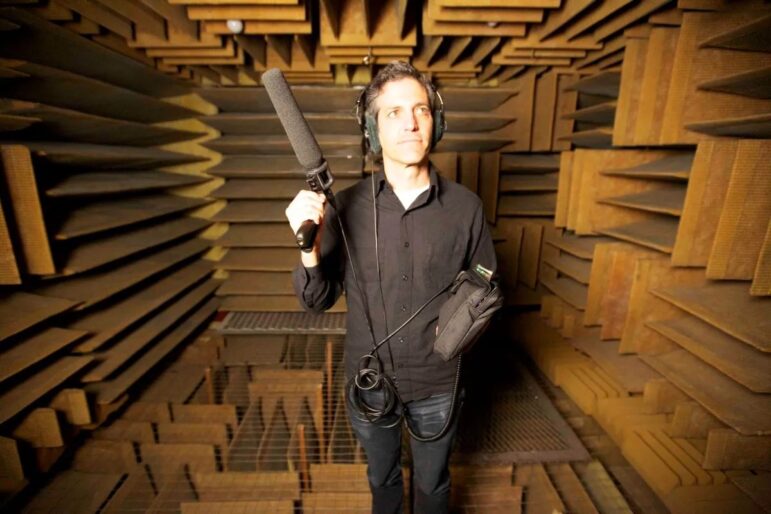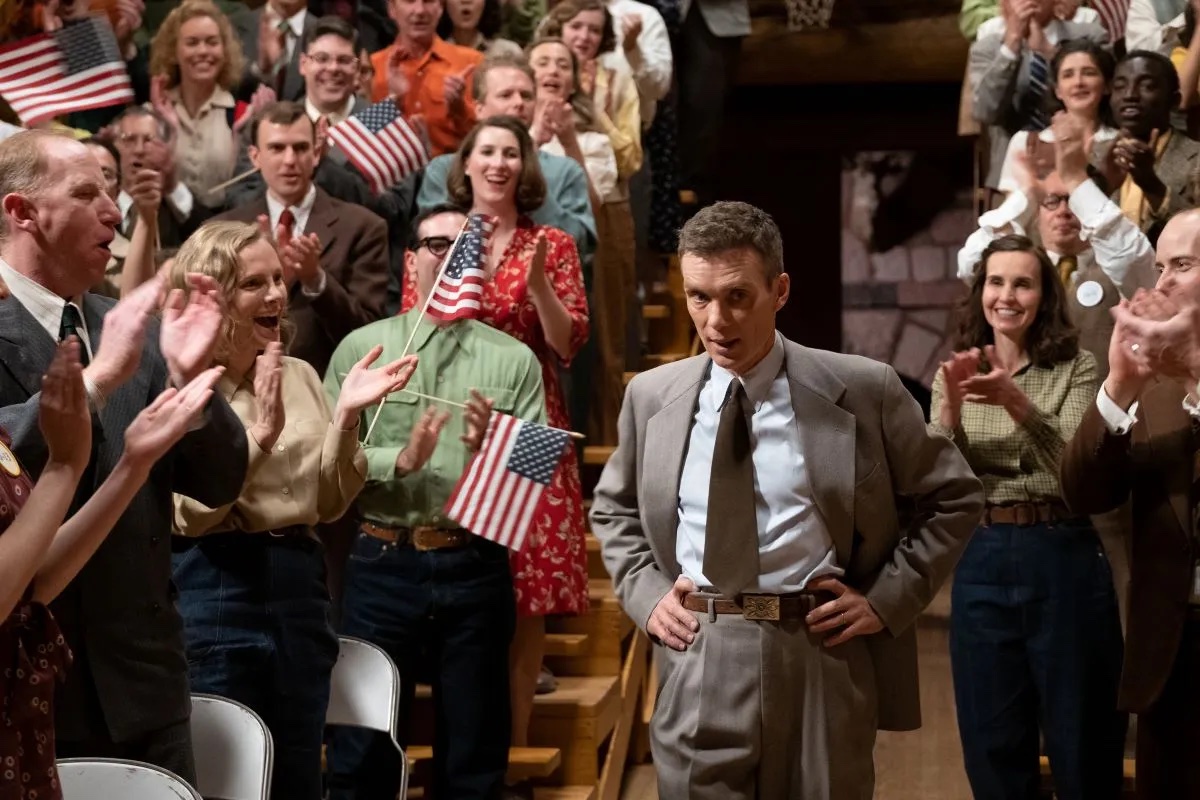Hear me out on this. There are three current films—two in theaters and one available to stream—wherein sound plays a pivotal role: “32 Sounds,” “Oppenheimer” and, to a lesser extent, “Stephen Curry: Underrated.”
Let’s start with Sam Green’s transcendent “32 Sounds,” an immersive sensory experience that explores the ways sound has a profound effect on our lives. In this beautiful, enlightening and interactive film, Green (2002’s “The Weather Underground” and 2018’s “A Thousand Thoughts”) and composer-DJ JD Samson catalog, as the title proclaims, 32 sounds.
The documentary is incredibly moving, and unlike anything I’ve seen recently. In it, the affable Green visits individuals who have been enchanted by or involved with sound, be it professionally or personally. He introduces a foley who creates the sound of a tree falling in the woods, a scene we first watch minus sound and then later with it.

We also encounter Annea Lockwood, a composer whose connection to nature creates some of the most soothing soundtracks featuring rivers, birds, and even the playful voices of nascent lovers. Her simple observation — “listening with rather than to” nature — is such a calming yet revolutionary concept, you’ll immediately want to put the theory into practice.
Other sounds covered skew to the more personal, even heart wrenching sort, such as listening to tapes of a departed friend, lover, and/or relative. In one sobering moment, Green listens to the taped greeting phone greeting from his brother, who committed suicide. It’s touching.
Each sequence asks us to be curious and ponder how sound has an impact and influences. We learn how others experience it, including a person who is deaf. Perhaps one of the most mind-blowing parts occurs when audience members put on a headset and experience 3-D sound.
It’s awe-inspiring, illustrating why this film demands to be seen in a theater. Green will be attending screenings this weekend: at 7 p.m. Thursday at San Francisco’s Exploratorium (live version with headphones and Green narration); 7:30 p.m. Friday in San Rafael at the Smith Rafael Center (theatrical headphones version, Q&A with Green); 1 p.m. Saturday at San Francisco’s Roxie (theatrical headphones version, Q&A with Green); 8 p.m. Saturday at the Smith Rafael Film Center (theatrical headphones version, Q&A with Green); 1 p.m. Sunday at the Smith Rafael Film Center (theatrical headphones version); 1 and 5 p.m. Sunday at the Elmwood Theater in Berkeley (theatrical headphones version, Q&A).
The use of sound figures prominently, as is the case of the bulk of its filmmakers’ work, in one of 2023’s most eagerly awaited, highly praised movies, “Oppenheimer.”
While director Chrisopher Nolan leaned in too heavily with sound for 2020’s impenetrable puzzle “Tenet,” all but obscuring slabs of dialogue, with “Oppenheimer” he tempers that frustrating tendency and sticks to the foundational principles of the biopic. It’s the right move for such meaty material.
Shot partially on the University of California, Berkeley campus (the Campanile and Edwards Stadium make guest appearances), Nolan’s three-hour epic covers the career, loves, brilliance, and metaphysical crisis of J. Robert Oppenheimer, who has been dubbed “the father of the atomic bomb.”
“Oppenheimer” is one of the smartest summer movies you’re likely to see.
But does it live up to the hype that it is one of the most important movies ever? Well, history will prove that. Let’s concern ourselves with the here and now. On a technical basis — editing, cinematography, and, yes, sound — “Oppenheimer” excels. It’s also filled with impressive performances, including Cillian Murphy as the enigmatic Oppenheimer, a pioneering physicist and UC Berkeley professor who got tagged to head the Manhattan Project, a position that would haunt him for the rest of his life.
The dapper Oppenheimer’s realization that the scientific breakthrough he helped create could also have the Prometheus-like power to destroy everything in its path is one of the most effective elements of “Oppenheimer.” One sequence in particular stands out, where Oppenheimer stares into a celebratory crowd and sees surreal images of the crowd’s annihilation. It’s an unforgettable moment, along with a scene depicting the nerve-wracking successful Los Alamos test, a prelude to the devastation ahead. Both are feats of pure cinematic magic.
Nolan sensitively yet powerfully handles traumatic material; there are no graphic scenes of the horrific aftermath when President Harry Truman authorized in 1945 the dropping of bombs on Hiroshima and Nagasaki. He excels at conveying the moral reckoning Oppenheimer encounters and the Pandora’s Box that he and others unleashed.
Other scenes, including the closing sequence, are equally compelling, such as the revealing exchanges between Oppenheimer and Lewis Strauss, the shrewd political chairman of the Atomic Energy Commission. They open a window to history some might not know.
It also helps that Robert Downey Jr. as Strauss delivers one of his finest performances ever as the duplicitous, power grubber. Emily Blunt is deserving (as is Downey Jr.) for awards consideration as Oppenheimer’s wife, Kitty, who knew of her husband’s extramarital affairs but remained steadfast beside him, even if she didn’t like it.
Although Florence Pugh’s screen time is limited, the talented actor gives it her all as the troubled Jean Tatlock, a Stanford University-trained psychiatrist and communist. But many of her scenes require her to be nude, and that frequency makes one later unclothed scene, in which she and Murphy are together, not as effective as it could have been.
While “Oppenheimer” could have more successful moments, there’s little doubt it’s one of the most ambitious, smartest, and exactingly executed films of the year. Does it shed new light on who the enigmatic Oppenheimer really was? Not really. But it does powerfully illustrate the responsibilities that come with scientific and technological breakthroughs, a message that remains as topical as ever.
The best way to view “Oppenheimer” is in IMAX, particularly in the 70mm format in the Bay Area, at San Francisco’s Metreon and Dublin’s Regal Hacienda Crossings and IMAX.

Finally, there’s rarely a happier sound than hearing sports fans cheer a spectacular play or basketball shot. Golden State Warriors Stephen Curry’s been the athlete providing many of those joyful moments for Bay Area fans. The extraordinary basketball player, and now, golfer, gives us even more reason to admire, respect and revere him with “Stephen Curry: Underrated,” available now on Apple TV+.
Oakland documentary maker Peter Nicks’ feature combines archival footage of an underdog college-age Curry at Davidson College along with footage of the Warriors during the nerve wracking 2021-22 season. The result is an inspiring documentary about an inspirational athlete who has defied detractors. And though you might be well-versed on the outcomes of the games on which the talented Nicks focuses, you’ll still gnash your teeth and cheer for one of the best athletes in the world. It’s an insightful look into how Curry became one of the greatest basketball players ever.
